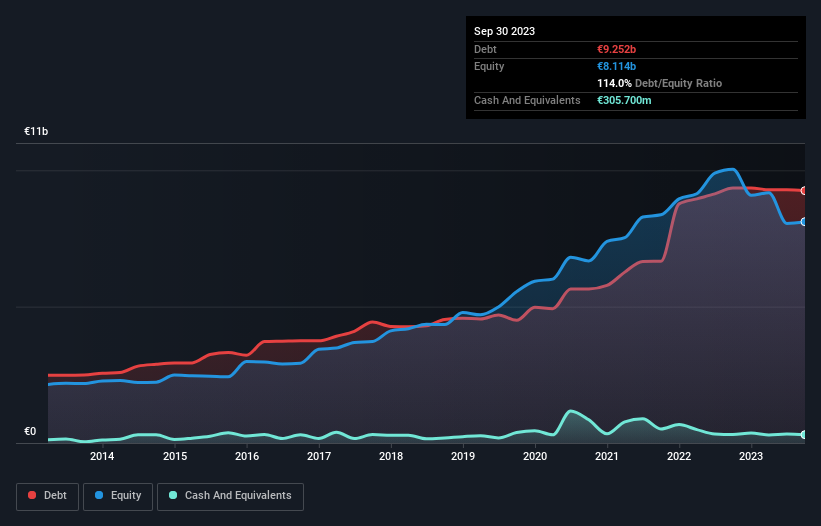
David Iben put it well when he said, 'Volatility is not a risk we care about. What we care about is avoiding the permanent loss of capital.' When we think about how risky a company is, we always like to look at its use of debt, since debt overload can lead to ruin. We note that LEG Immobilien SE (ETR:LEG) does have debt on its balance sheet. But the more important question is: how much risk is that debt creating?
What Risk Does Debt Bring?
Debt assists a business until the business has trouble paying it off, either with new capital or with free cash flow. In the worst case scenario, a company can go bankrupt if it cannot pay its creditors. However, a more usual (but still expensive) situation is where a company must dilute shareholders at a cheap share price simply to get debt under control. Of course, plenty of companies use debt to fund growth, without any negative consequences. When we examine debt levels, we first consider both cash and debt levels, together.
View our latest analysis for LEG Immobilien
What Is LEG Immobilien's Net Debt?
The chart below, which you can click on for greater detail, shows that LEG Immobilien had €9.25b in debt in September 2023; about the same as the year before. However, it also had €305.7m in cash, and so its net debt is €8.95b.

A Look At LEG Immobilien's Liabilities
We can see from the most recent balance sheet that LEG Immobilien had liabilities of €1.39b falling due within a year, and liabilities of €10.6b due beyond that. Offsetting this, it had €305.7m in cash and €263.7m in receivables that were due within 12 months. So its liabilities total €11.4b more than the combination of its cash and short-term receivables.
This deficit casts a shadow over the €5.44b company, like a colossus towering over mere mortals. So we'd watch its balance sheet closely, without a doubt. After all, LEG Immobilien would likely require a major re-capitalisation if it had to pay its creditors today.
We use two main ratios to inform us about debt levels relative to earnings. The first is net debt divided by earnings before interest, tax, depreciation, and amortization (EBITDA), while the second is how many times its earnings before interest and tax (EBIT) covers its interest expense (or its interest cover, for short). The advantage of this approach is that we take into account both the absolute quantum of debt (with net debt to EBITDA) and the actual interest expenses associated with that debt (with its interest cover ratio).
LEG Immobilien has a rather high debt to EBITDA ratio of 16.4 which suggests a meaningful debt load. However, its interest coverage of 4.3 is reasonably strong, which is a good sign. On the other hand, LEG Immobilien grew its EBIT by 28% in the last year. If it can maintain that kind of improvement, its debt load will begin to melt away like glaciers in a warming world. There's no doubt that we learn most about debt from the balance sheet. But ultimately the future profitability of the business will decide if LEG Immobilien can strengthen its balance sheet over time. So if you're focused on the future you can check out this free report showing analyst profit forecasts.
Finally, a company can only pay off debt with cold hard cash, not accounting profits. So it's worth checking how much of that EBIT is backed by free cash flow. During the last three years, LEG Immobilien produced sturdy free cash flow equating to 70% of its EBIT, about what we'd expect. This cold hard cash means it can reduce its debt when it wants to.
Our View
While LEG Immobilien's net debt to EBITDA makes us cautious about it, its track record of staying on top of its total liabilities is no better. But at least its EBIT growth rate is a gleaming silver lining to those clouds. When we consider all the factors discussed, it seems to us that LEG Immobilien is taking some risks with its use of debt. So while that leverage does boost returns on equity, we wouldn't really want to see it increase from here. When analysing debt levels, the balance sheet is the obvious place to start. But ultimately, every company can contain risks that exist outside of the balance sheet. Case in point: We've spotted 1 warning sign for LEG Immobilien you should be aware of.
If, after all that, you're more interested in a fast growing company with a rock-solid balance sheet, then check out our list of net cash growth stocks without delay.
New: AI Stock Screener & Alerts
Our new AI Stock Screener scans the market every day to uncover opportunities.
• Dividend Powerhouses (3%+ Yield)
• Undervalued Small Caps with Insider Buying
• High growth Tech and AI Companies
Or build your own from over 50 metrics.
Have feedback on this article? Concerned about the content? Get in touch with us directly. Alternatively, email editorial-team (at) simplywallst.com.
This article by Simply Wall St is general in nature. We provide commentary based on historical data and analyst forecasts only using an unbiased methodology and our articles are not intended to be financial advice. It does not constitute a recommendation to buy or sell any stock, and does not take account of your objectives, or your financial situation. We aim to bring you long-term focused analysis driven by fundamental data. Note that our analysis may not factor in the latest price-sensitive company announcements or qualitative material. Simply Wall St has no position in any stocks mentioned.
About XTRA:LEG
Moderate growth potential second-rate dividend payer.


